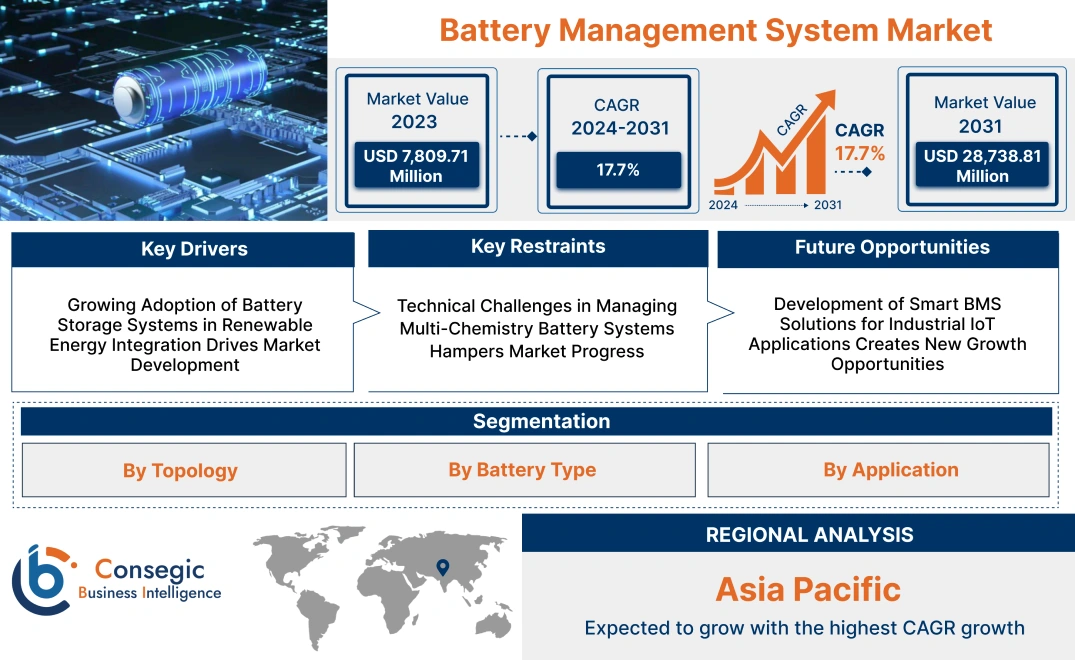- Summary
- Table Of Content
- Methodology
Battery Management System Market Size:
Battery Management System Market size is estimated to reach over USD 28,738.81 Million by 2031 from a value of USD 7,809.71 Million in 2023 and is projected to grow by USD 9,247.29 Million in 2024, growing at a CAGR of 17.7% from 2024 to 2031.
Battery Management System Market Scope & Overview:
A Battery Management System (BMS) is an electronic system designed to monitor and manage the performance of rechargeable batteries, ensuring optimal operation, safety, and longevity. BMS plays a crucial role in balancing battery cells, protecting against overcharging, overheating, and deep discharging, and providing real-time data on battery status and health. These systems are essential for applications across various sectors, including electric vehicles (EVs), renewable energy storage, consumer electronics, and industrial equipment, where they enhance battery efficiency, extend lifespan, and ensure reliable power supply.
Technological advancements in battery technologies and the growing focus on energy efficiency are further boosting market expansion. The integration of BMS in EVs, renewable energy systems, and portable electronics ensures enhanced safety, performance, and cost-effectiveness, addressing the evolving needs of various industries.
Key end-users of BMS include automotive manufacturers, renewable energy providers, consumer electronics companies, and industrial equipment suppliers. As industries continue to prioritize energy efficiency and safety, the need for advanced Battery Management Systems is expected to grow, driven by the need for reliable and efficient battery performance.
Battery Management System Market Dynamics - (DRO) :
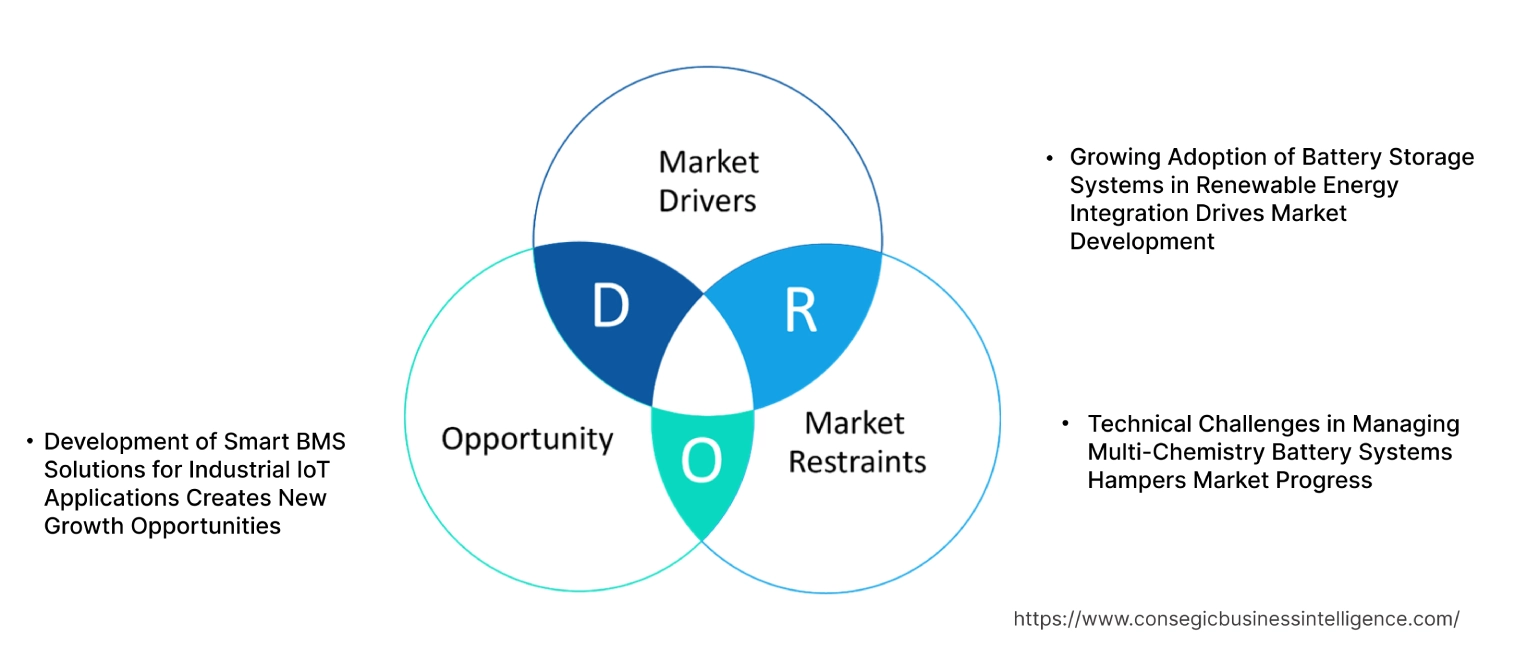
Key Drivers:
Growing Adoption of Battery Storage Systems in Renewable Energy Integration Drives Market Development
The increasing integration of renewable energy sources like solar and wind into the power grid is propelling the demand for battery energy storage systems (BESS), which rely heavily on effective BMS solutions. As the variability of renewable energy output poses challenges for grid stability, large-scale battery storage systems are essential for storing excess energy and balancing supply and demand. BMS technology plays a critical role in optimizing the performance of these storage systems, ensuring efficient energy use, state-of-charge (SOC) monitoring, and preventing battery degradation over time. The trend towards decentralized energy production, including residential and commercial microgrids, further accelerates the need for advanced BMS capable of managing diverse battery chemistries and supporting smart grid applications. This shift is driving investments in cutting-edge BMS technologies tailored for energy storage applications, facilitating the battery management system market growth.
Key Restraints :
Technical Challenges in Managing Multi-Chemistry Battery Systems Hampers Market Progress.
One of the significant restraints in the battery management system market is the complexity involved in managing multi-chemistry battery systems, particularly in applications that require a mix of different battery types (e.g., lithium-ion, solid-state, and lead-acid batteries). Each battery chemistry has unique characteristics, including varying charge/discharge rates, temperature sensitivities, and voltage requirements. Integrating a BMS that effectively monitors, balances, and protects a system with mixed battery chemistries is challenging due to the need for customized algorithms and hardware configurations. Additionally, multi-chemistry systems are often used in applications like hybrid energy storage solutions, where seamless integration is critical to prevent performance issues and safety risks. The technical complexities and high costs associated with developing a versatile BMS capable of managing different battery chemistries limit market growth, especially for applications requiring precise control and high reliability. Thus, due to the aforementioned constraints, it hinder the battery management system market demand.
Future Opportunities :
Development of Smart BMS Solutions for Industrial IoT Applications Creates New Growth Opportunities.
The rising adoption of Industrial IoT (IIoT) technologies in sectors such as manufacturing, logistics, and infrastructure presents a significant opportunity for the battery management system market. Smart BMS solutions integrated with IIoT platforms enable real-time monitoring, predictive maintenance, and enhanced data analytics for industrial battery applications. In industrial settings, the efficient management of battery systems is critical for ensuring uninterrupted power supply to essential equipment, optimizing operational efficiency, and reducing maintenance costs. By leveraging IIoT capabilities, BMS provides detailed insights into battery health, lifecycle performance, and energy consumption patterns, allowing for proactive maintenance and reducing downtime. The integration of IIoT-driven BMS is particularly valuable in sectors like automated warehouses, smart factories, and critical infrastructure, where reliable battery performance is crucial. As industries continue to embrace IIoT, the need for smart, connected BMS solutions is expected to grow, creating battery management system market opportunities.
Battery Management System Market Segmental Analysis :
By Topology:
Based on topology, the battery management system market is segmented into centralized, distributed, and modular BMS.
The centralized topology segment accounted for the largest revenue of 62.44% in 2023.
- Centralized topology features a single control unit managing all battery cells, making it suitable for small to mid-sized applications.
- This configuration is preferred in consumer electronics and small electric vehicles due to its simplicity and lower cost.
- Centralized systems offer advantages such as reduced complexity in wiring and easier maintenance, making them a cost-effective choice for various applications.
- The segment's dominance is driven by its straightforward design, making it ideal for applications where wiring complexity is not a major concern.
- Centralized topology leads the market due to its cost-effectiveness and ease of implementation in small and medium-sized battery systems.
- As per the battery management system market analysis, the centralized topology segment boosts the market progress.
The modular topology segment is anticipated to register the fastest CAGR during the forecast period.
- Modular topology uses multiple modules, each managing a group of battery cells, offering a balance between centralized and distributed systems.
- This topology is ideal for mid-to-large-sized applications, providing scalability and flexibility, making it popular in electric vehicles (EVs) and industrial applications.
- The increasing adoption of EVs and the need for scalable battery management solutions are driving demand for modular BMS.
- The modular approach offers benefits like easier maintenance and the ability to handle larger battery packs efficiently, making it a preferred choice in the automotive and renewable energy sectors.
- Modular topology is expected to grow rapidly, driven by its scalability and flexibility in handling complex battery systems in various industries.
- As per battery management system market trends, the modular topology segment fuels the market development.
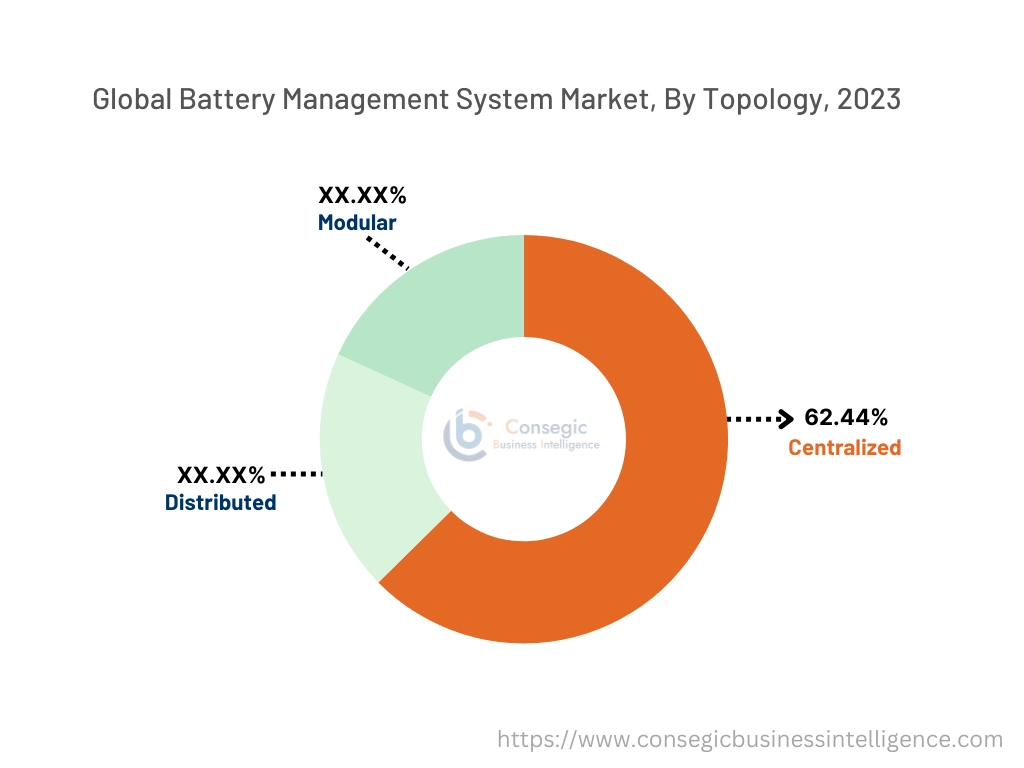
By Battery Type:
Based on battery type, the market is segmented into lithium-ion, lead-acid, nickel-based, flow batteries, and others.
The lithium-ion battery segment accounted for the largest revenue share of the total battery management system market share in 2023.
- Lithium-ion batteries are widely used due to their high energy density, long cycle life, and broad application across multiple industries.
- They are the preferred choice for electric vehicles, portable electronics, and renewable energy storage systems, where performance and longevity are key factors.
- The growing requirement for electric vehicles and advancements in renewable energy solutions have significantly increased the need for lithium-ion battery management systems.
- Innovations in battery technology, including solid-state lithium-ion batteries, are further enhancing the performance and safety of BMS in this segment.
- Lithium-ion batteries lead the market due to their superior performance characteristics and extensive application scope across various industries.
- Therefore, as per segmental trends analysis, the lithium-ion segment drives the battery management system market expansion.
The flow batteries segment is anticipated to register the fastest CAGR during the forecast period.
- Flow batteries are gaining popularity in large-scale energy storage applications due to their scalability and capability for long-duration energy storage.
- These batteries are particularly suited for renewable energy storage, including solar and wind power storage, as well as grid-scale energy storage solutions.
- The increasing focus on renewable energy projects and the need for efficient, long-duration storage systems are driving progress in the flow battery segment.
- Flow batteries offer advantages such as easy scalability and lower thermal runaway risk, making them a preferred choice for grid and commercial energy storage applications.
- The flow batteries segment is expected to grow rapidly due to the rising adoption of renewable energy storage systems and the need for scalable, efficient battery solutions.
- As per segmental trends analysis, the flow batteries segment boosts the market development.
By Application:
Based on application, the battery management system market is segmented into electric vehicles (EVs), portable electronics, industrial automation, and renewable energy storage systems.
The electric vehicles (EVs) segment accounted for the largest revenue share in 2023.
- Electric vehicles require advanced BMS to manage large battery packs, ensuring safety, efficiency, and optimal performance.
- The rapid progress of the EV market, driven by environmental regulations and the shift towards sustainable transportation, is a key driver of demand for BMS.
- BMS enhances the lifespan of EV batteries, improves energy efficiency, and provides real-time monitoring and diagnostics, crucial for vehicle safety and performance.
- Major automakers are investing heavily in advanced BMS technologies to improve the reliability and safety of their electric vehicle offerings.
- The EV segment leads the market due to the increasing need for electric vehicles and the essential role of BMS in managing battery performance and safety.
- As per segmental trends analysis, the electric vehicles (EVs) segment boosts the battery management system market development.
The renewable energy storage systems segment is anticipated to register the fastest CAGR during the forecast period.
- Renewable energy storage systems rely on BMS to optimize battery performance, manage charging and discharging cycles, and ensure efficient energy use.
- The increasing adoption of renewable energy sources like solar and wind, combined with the need for reliable, large-scale energy storage solutions, is driving demand for BMS in this segment.
- BMS plays a critical role in maintaining battery health, preventing overcharging, and balancing energy loads, which enhances the overall efficiency of storage systems.
- Government incentives and investments in renewable energy projects are further propelling the growth of this segment, especially in grid-scale storage applications.
- The renewable energy storage systems segment is expected to grow rapidly due to the rising focus on sustainable energy solutions and the demand for efficient battery management.
- As per segmental trends analysis, the renewable energy storage systems segment boosts the battery management system market growth.
Regional Analysis:
The regions covered are North America, Europe, Asia Pacific, the Middle East and Africa, and Latin America.
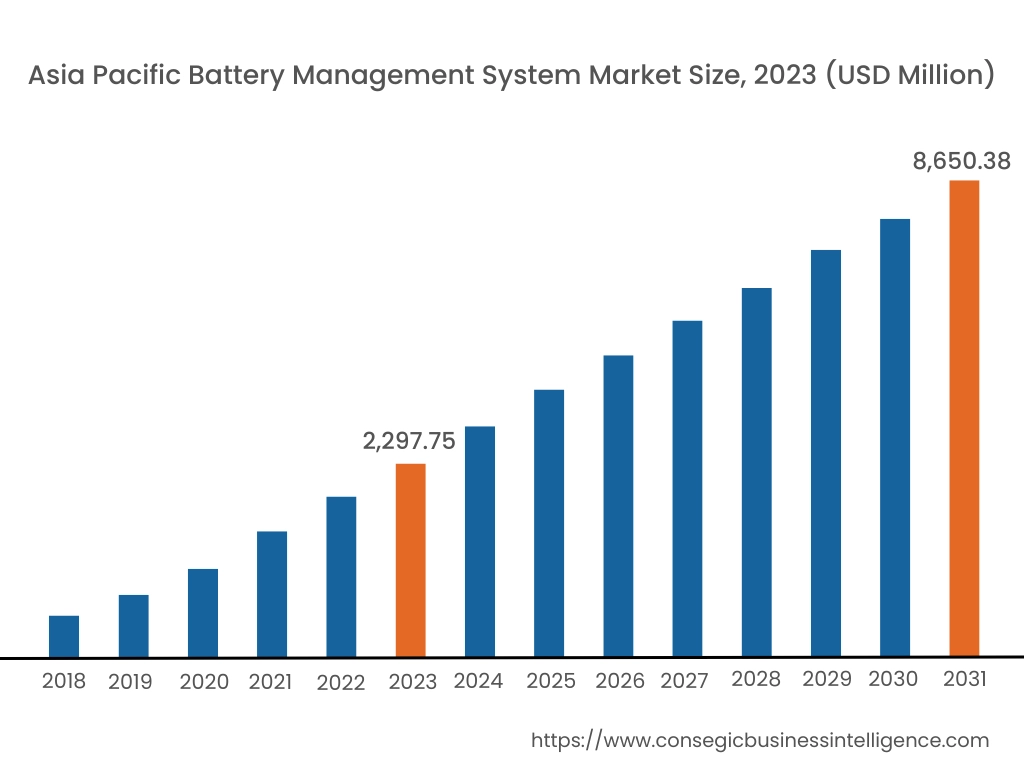
Asia Pacific region was valued at USD 2,297.75 Million in 2023. Moreover, it is projected to grow by USD 2,725.93 Million in 2024 and reach over USD 8,650.38 Million by 2031. Out of these, China accounted for the largest share of 33.7% in 2023. Asia-Pacific is witnessing the fastest growth in the BMS market, driven by increasing automotive production, rising disposable incomes, and rapid urbanization in countries like China, Japan, and India. The region has become a global hub for EV manufacturing, with a strong supply chain and cost advantages. The growing demand for consumer electronics, automotive electronics, and renewable energy storage systems contributes to market development.
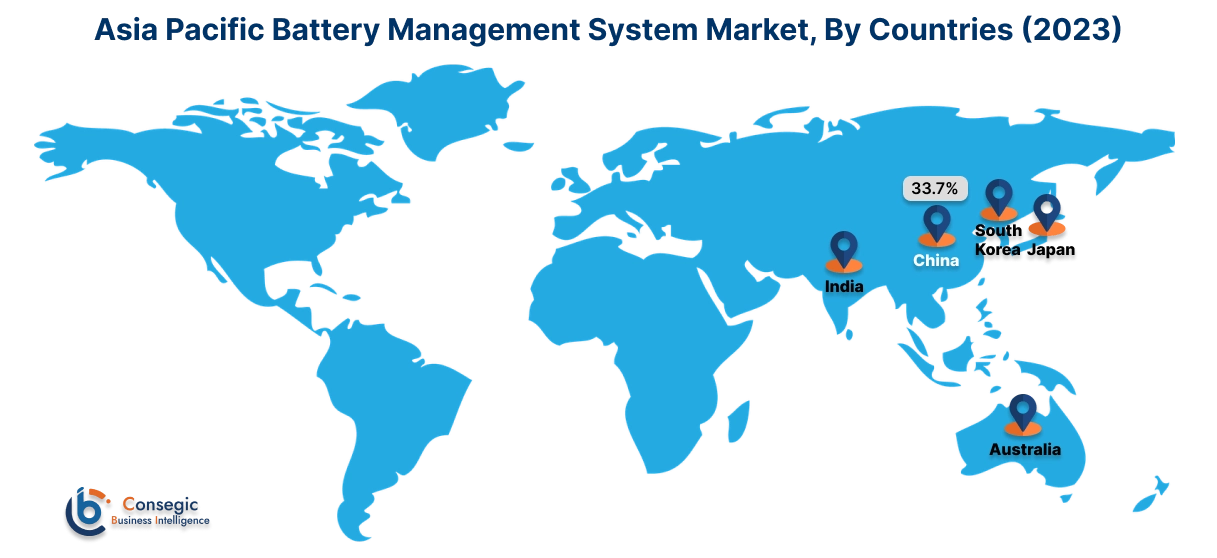
North America is estimated to reach over USD 9,627.50 Million by 2031 from a value of USD 2,601.22 Million in 2023 and is projected to grow by USD 3,081.52 Million in 2024. This region holds a substantial share of the BMS market, primarily due to a well-established automotive industry and early adoption of EVs. The United States, in particular, has a significant market presence, with major automotive manufacturers and technology companies investing heavily in battery technologies. The requirement for advanced BMS solutions is propelled by the need for efficient energy storage systems and the integration of renewable energy sources.
Europe represents a significant share of the global BMS market, with countries like Germany, the UK, and France leading in terms of adoption and innovation. The region benefits from strong government support for sustainable energy initiatives and stringent emission regulations, which drive the integration of BMS in EVs and renewable energy systems. The focus on reducing carbon footprints and enhancing energy efficiency further accelerates the adoption of BMS solutions.
The Middle East & Africa region shows promising potential in the BMS market, particularly in countries like the UAE, Saudi Arabia, and South Africa. Increasing investments in infrastructure, a growing consumer electronics market, and government initiatives to promote renewable energy adoption drive the need for BMS solutions. The expanding telecommunications sector and the adoption of smart technologies further support market development.
Latin America is an emerging market for BMS, with Brazil and Mexico being the primary growth drivers. The rising adoption of consumer electronics, improving industrialization, and increasing focus on enhancing energy storage capabilities contribute to the market's expansion. Government initiatives aimed at modernizing energy infrastructure and promoting foreign investments support market growth.
Top Key Players & Market Share Insights:
The Battery Management System market is highly competitive with major players providing products and services to the national and international markets. Key players are adopting several strategies in research and development (R&D), product innovation, and end-user launches to hold a strong position in the global Battery Management System market. Key players in the Battery Management System industry include –
- Eberspächer (Germany)
- Sensata Technologies, Inc. (USA)
- Leclanché SA (Switzerland)
- Renesas Electronics Corporation (Japan)
- LION Smart GmbH (Germany)
- Elithion Inc. (USA)
- Nuvation Energy (USA)
- Texas Instruments Incorporated (USA)
- Ewert Energy Systems, Inc. (USA)
- STAFL Systems, LLC. (USA)
Recent Industry Developments :
Product Launch:
- In November 2024, NXP announced its Ultra-Wideband Wireless Battery Management System Solution. Its role in BMS is crucial for electric vehicles, as UWB can accurately monitor battery parameters in real time, ensuring better energy distribution, thermal regulation, and overall system safety. By enabling precise communication within the BMS, UWB technology helps to extend battery life and enhance operational safety in EV applications.
- In November 2024, ABLIC introduced the S-19193, a high-performance battery protection IC designed for lithium-ion batteries used in automotive and industrial applications. It offers advanced safety features such as overcurrent detection and temperature monitoring, enhancing battery reliability and longevity. This IC is particularly useful in electric vehicles (EVs) and energy storage systems, ensuring precise control over battery conditions. Its low power consumption also helps extend battery life in critical environments.
- In September 2024, LG Energy Solution launched the brand "B.around" to provide a comprehensive Battery Management Total Solution (BMTS). This brand offers advanced safety and battery degradation diagnostics, leveraging real-time monitoring to ensure optimal performance and longevity. The BMTS includes hardware and software solutions, optimized for software-defined vehicles (SDVs), and utilizes AI and cloud technologies. LG's unique battery expertise, built from analyzing over 130,000 battery cells, powers this offering for the next generation of electric vehicles.
Battery Management System Market Report Insights :
| Report Attributes | Report Details |
| Study Timeline | 2018-2031 |
| Market Size in 2031 | USD 28,738.81 Million |
| CAGR (2024-2031) | 17.7% |
| By Topology |
|
| By Battery Type |
|
| By Application |
|
| By Region |
|
| Key Players |
|
| North America | U.S. Canada Mexico |
| Europe | U.K. Germany France Spain Italy Russia Benelux Rest of Europe |
| APAC | China South Korea Japan India Australia ASEAN Rest of Asia-Pacific |
| Middle East and Africa | GCC Turkey South Africa Rest of MEA |
| LATAM | Brazil Argentina Chile Rest of LATAM |
| Report Coverage |
|
